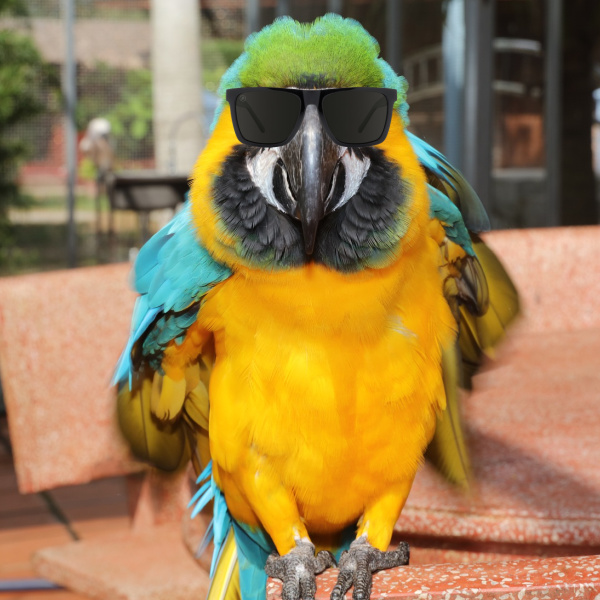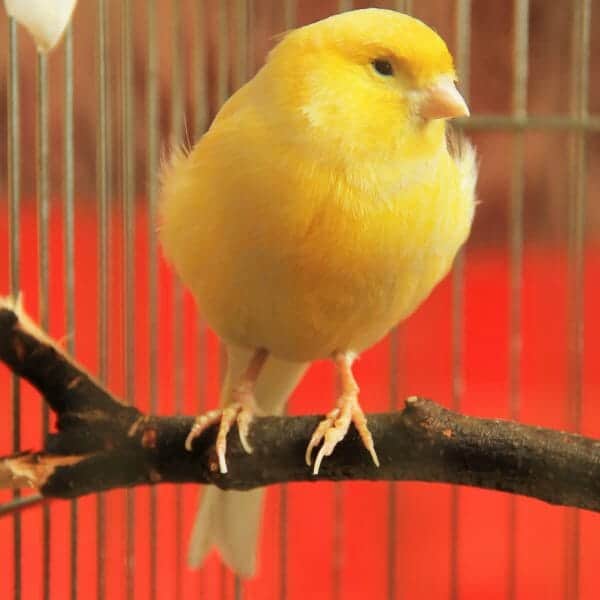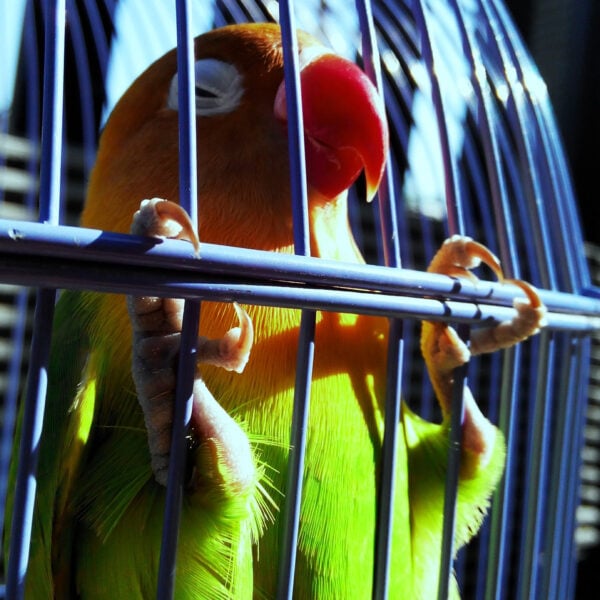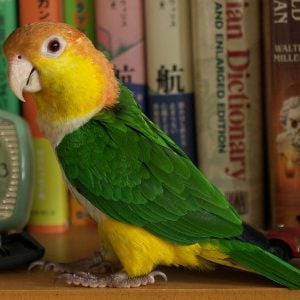
Can A Macaw Parrot Get Cataracts?
Last Updated on by Catherine Tobsing
Can you do anything for this?
I have a Catalina macaw she is 30.
Her right eye seems to be not as clear as her left. It’s like a very lite graying.
Sometimes she bumps into things.
Her diet consists of seeds and pellets she also gets prime vitamins in her water
Also a little treat from our dinner plates at night.
Thanks
Steven
Hi Steven
Unlike humans, it’s easier to detect cataracts in birds.
When you say “her right eye seems not to be as clear as her left, it doesn’t sound like a cataract because cataracts in birds manifest themselves in the pupil.”
The question really needs to be answered by an avian veterinarian.
Humans require an optometrist or ophthalmologist using sophisticated instruments to determine the presence of a cataract and how much it impairs eyesight.
I’m certainly no expert on cataracts but I’ve chosen the subject this week because I just finished having cataract surgery on both of my own eyes and you can read about it here.
Most likely you’ll see whiteness in the bird’s pupil.
Cataracts can be age-related in both birds and humans but metabolic diseases like diabetes and infections can trigger cataracts in birds.
Nutritional deficiencies can also trigger cataracts which is why I consistently beat the drum to feed your bird commercial food so you know the nutritional value of what your bird is eating.
Cataracts are seen a lot in canaries but not so much in Amazons, Macaws, and Greys.
Cataracts can actually be genetically predisposed in canaries.
Cataracts will affect your bird’s vision and could possibly even lead to blindness.
Sometimes humans don’t realize their birds are blind until it’s pointed out by a veterinarian.
If you get the unfortunate diagnosis, the bird’s wings must be clipped so he or she cannot fly.
Whereas we recommend changing everything in the birdcage on a regular basis, the opposite would hold true for a blind bird.
The interior of the cage must remain very stable so the bird can confidently move about the cage, especially for food and water.
The good news is that cataracts can be treated surgically in birds but it’s not always the case.
One of the issues with surgery is that birds are for more sensitive to anesthesia than mammals.
Your vet will most likely perform pre-anesthetic diagnostic tests to ensure there are no internal problems with the bird.
This webpage from Long Beach animal Hospital walks you through a macaw cataract surgery but the pictures are very graphic – you’ve been warned.
If surgery is not an option, ocular medications (NSAIDs) like flurbiprofen, celecoxib or meloxicam will keep pain and inflammation down in your bird’s eye.
You will want to monitor a bird with cataracts closely inspecting the eyes on a regular basis.
I don’t want to overwhelm my readers with complicated data but I found this study interesting.
I highlighted the information about cataracts and birds but was surprised to find how prevalent they were.
1. J Zoo Wildl Med. 2015 Dec;46(4):858-69. doi: 10.1638/2015-0071.1.
RETROSPECTIVE INVESTIGATION OF CATARACT MANAGEMENT IN AVIAN SPECIES IN A ZOOLOGIC
COLLECTION.
Rainwater KL, Sykes JM, Sapienza JS.
A review of avian cataracts at the Wildlife Conservation Society’s Bronx Zoo between 1992 and 2011 was conducted.
Ninety cataracts in 54 birds from 42 species were identified.
Cataracts were found primarily during examination for ocular abnormalities (29/54, 53.7%) or opportunistically (13/54, 24.1%) and were most commonly diagnosed as mature (22/90, 24.4%).
Systemic medical conditions diagnosed in these birds included West Nile virus (4/54, 7.4%), head trauma (3/54, 5.6%), plumbism and Salmonella Pullorum (1/54, 1.9%), Marek’s disease (1/54, 1.9%), leukocytosis (1/54, 1.9%), and hyperglycemia (1/54, 1.9%).
Cataracts were progressive in seven birds of four species.
Unilateral enucleation was performed in 2/54 (3.7%) birds, and 12/54 (22.2%) underwent cataract removal (phacoemulsification in 16 eyes and standard extracapsular cataract extraction in 2 eyes).
Concurrent ocular abnormalities, such as corneal scarring and lens-induced uveitis, were seen in 2/18 (11.1%) eyes preoperatively in the group undergoing cataract removal, 2/2 (100%) eyes preoperatively in the group undergoing enucleation, and 33/70 (47.1%) of eyes that did not undergo surgery.
For birds undergoing cataract removal, complications included successfully treated cardiorespiratory arrest intraoperatively (1/12, 8.3%) as well as
postanesthetic complications of acute respiratory distress and tracheal stricture (2/12, 16.7%).
The most common postoperative ocular abnormalities included posterior capsular opacity (4/18 eyes, 22.2%) and corneal scarring (2/18 eyes, 11.1%).
Lens cortical regrowth and marked posterior lens capsular opacity occurred in one eye of one bird after phacoemulsification, necessitating a second ocular surgery.
A successful outcome, as determined by improved postoperative visual acuity, was seen in 10/12 (83.3%) birds undergoing cataract removal, and 5/12 (41.7%) of these birds were alive 3 yr after surgery.
The results of this review will aid clinicians in identifying common stages of cataracts, determining eligibility for cataract surgery, and managing postoperative complications in avian patients.
DOI: 10.1638/2015-0071.1
PMID: 26667543 [Indexed for MEDLINE]
Hi, my cockatiel has a cataract in one eye, she is 3 years and 6 months old.
I am looking into whether the lamp she has is suitable and whether it is located correctly.
It is currently resting on the top of the cage, the cage is a large ferret cage.
The bulb I am using now is an Exo Terra natural light PT 2190, 13W, it was recommended for me by the pet store.
I looked it up and it is for reptiles, and I don’t think it has the UVB Spectrum, I did not get a reason for the cataracts from the vet.
The vet gave us non-steroidal anti-inflammatory eye drops to administer twice a day for life, not an easy thing to do.
Please advise on the lamp and where it’s located and give me your thoughts on the use of the drops.
Thank you very much.
Dawn
Hi Dawn
The lamp is fine – light is light. That said to be effective it’s not the light quality but the light cycle.
Your placement is fine all that’s needed is a timer for 12 hours on/off light cycles.
This helps keep your tiel’s circadian rhythm synchronized making for a less stressful bird.
As for the “lifetime of eyedrops,” I found this.
What if my pet’s Cataracts are left untreated?
Please refer to my answer above regarding Steven’s Catalina Macaw with possible cataracts.
If advanced cataracts are left untreated, over time they can luxate, or become loose from the structures that hold them in place.
This allows the cataract to shift positions within the eye where it can block the normal fluid flow leading to glaucoma.
Glaucoma is a painful and blinding disease that often leads to eye removal.
I would follow up each treatment with a high-value treat helping to take the “edge” off.
best of luck
Mitchr
Author Profile
Latest entries
 The Traveling BirdJune 26, 2025Can You Name 5 Parrot Species That Are Living Wild in the USA?
The Traveling BirdJune 26, 2025Can You Name 5 Parrot Species That Are Living Wild in the USA? Bird BehaviorJune 26, 2025How is it Parrots Are Problem Solvers Social Animals and Even Use Tools?
Bird BehaviorJune 26, 2025How is it Parrots Are Problem Solvers Social Animals and Even Use Tools? Bird & Parrot AnatomyJune 25, 2025How a Tiny Chemical Modification Makes Parrots Nature’s Living Paintings
Bird & Parrot AnatomyJune 25, 2025How a Tiny Chemical Modification Makes Parrots Nature’s Living Paintings PigeonsJune 20, 2025How Do Parrots Thrive in Cities Outside Their Native Habitats?
PigeonsJune 20, 2025How Do Parrots Thrive in Cities Outside Their Native Habitats?


